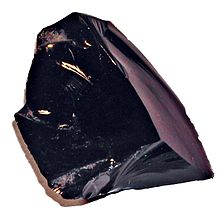Volcanic glass
As volcanic glass or rock glass , a is volcanic rock (or a part of a rock) denotes that is not crystalline is, but in the amorphous state as glass is present. This happens due to the very rapid cooling or quenching of a lava or magma so that no crystallization could take place. With volcanic glass it is not a question of a separate type of rock, but a specific rock structure . The best known example of rock glass is obsidian .
Emergence
A rock can consist entirely ( hyaline ) or only partially ( hypocrystalline ) of rock glass (in contrast to a glass-free, holocrystalline rock). There are all transitions between hyaline and holocrystalline rocks. In a hyaline rock, only a few tiny crystals appear, which under certain circumstances can form a flow structure . A porphyry rock, in which individual larger mineral grains appear as sprinkles in a vitreous base mass, is called Vitrophyr .

The rapid cooling required for the formation of rock glass is mostly achieved in nature through contact of lava with water or glacier ice. In the event of an explosive volcanic eruption, smaller lava particles ( tephra ) are deterred on their way through the air. The appearance of volcanic glasses at the contact between hot magma and water is typical. As pillow or pillow lava , they are formed on mid- ocean ridges and other submarine volcanoes . Rock glasses also appear on subglacial volcanoes (e.g. table volcanoes ). In the contact area of near-surface, small-scale intrusion bodies ( dykes or storage corridors ) to the cold adjacent rock, a glassy deterrent zone can develop, while the interior is more or less crystallized.
structure
Volcanic glasses are made from melts of various compositions. The chemistry of silica-rich and therefore very viscous (viscous) glass-forming rock melts varies from rhyolite to trachytic and andesitic to phonolithic . Low-SiO 2 rock glasses are of a basaltic composition. A rock glass is basically a supercooled melt that is in a metastable state. The molecules are still in a disordered amorphous state in the glass, as in the original melt and not in the ordered crystal structure of a solid . Due to its metastability, the glass transforms into a thermodynamically stable crystal structure over geological time ( recrystallization or devitrification ). The crystallization of the glass is based on crystallization nuclei (tiny crystals or impurities) around which radial spherulites form.
Examples
- Obsidian is a well-known example of a volcanic glass which, due to its fracture properties, was preferred by Stone Age cultures for the manufacture of tools and weapons. Depending on the chemism, one speaks of rhyolithic, phonolithic, andesitic etc. obsidian.
- Pechstein is a paleovulcanite that is partially devitrified and contains up to 10% H 2 O. Pechstein emerges from geologically old obsidian.
- Perlite also arises from the alteration of obsidian and consists of up to centimeter-sized, hydrated glass spheres with a concentric-shell structure.
- Tachylite is a basaltic rock glass , which u. a. occurs as deterrent crusts around pillow lavas.
- Hyaloclastite denotes a glass containing pyroclastic rock , which is formed by fragmentation in contact with water or glacial ice.
.
- Pumice is a very porous or foamy glass that is created from gas-rich magma during explosive volcanic eruptions.
- Limburgite is the name for a porphyry rock of basanite composition with a high proportion of glass in the matrix.
- Reticulit is an extremely porous and light, basaltic volcanic glass.
- Pele hair (also norn hair or witch hair) is volcanic glass pulled into thin threads by strong winds.
swell
- Richard V. Dietrich, Brian J. Skinner: The rocks and their minerals . Ott Verlag, Thun 1979, ISBN 0-471-02934-3

